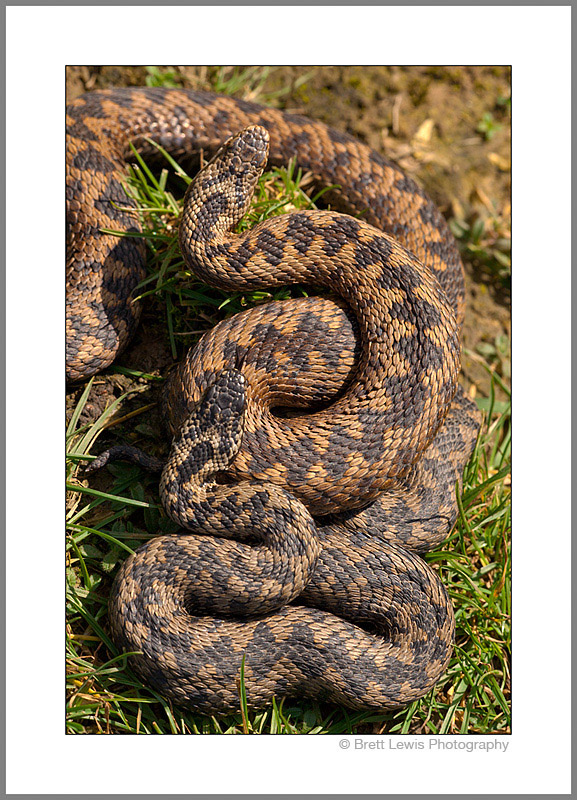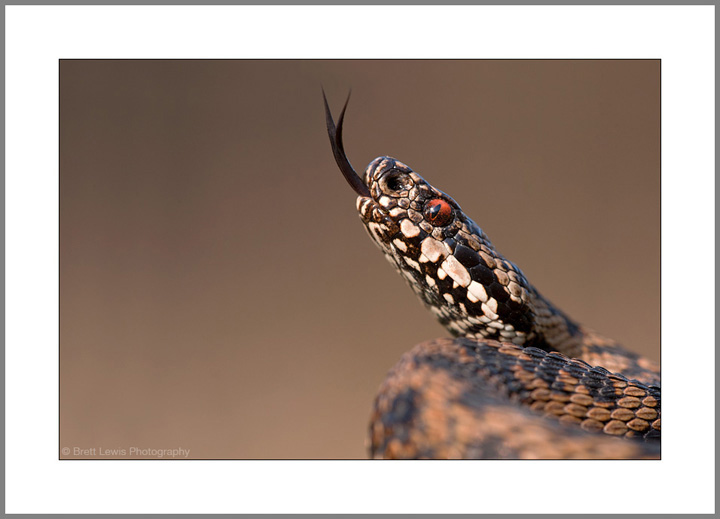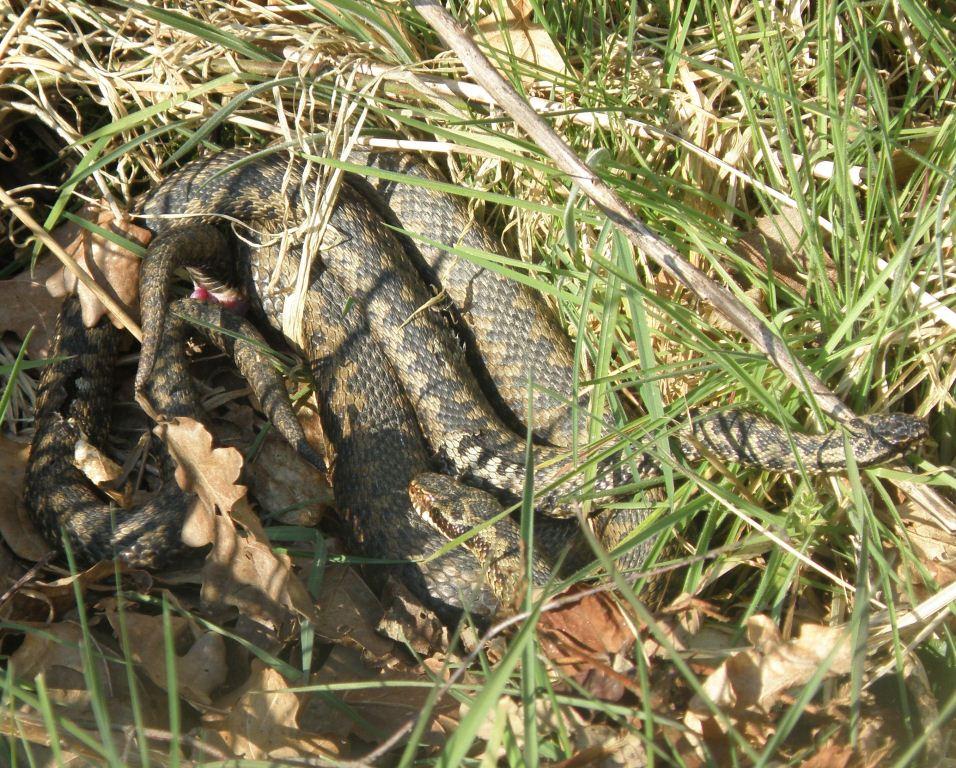 |
 |
Kent Adders: |
| Author | Message |
|
B Lewis Krag Committee Joined: 24 Aug 2004 No. of posts: 146  View other posts by B Lewis |
Posted: 20 Mar 2011 First time out to one of my monitoring sites yesterday for 2011 and I was not disappointed. A total of 8 Adder - 7 Male and 1 Female. Also 1 Male Slow- worm.. This recently emerged female was already being guarded..! 
Nice to be able to get a tongue flick too.. 
 Lewis Ecology Brett Lewis Photography Kent Reptile & Amphibian Group DICE - University of Kent |
|
B Lewis Krag Committee Joined: 24 Aug 2004 No. of posts: 146  View other posts by B Lewis |
Posted: 20 Mar 2011 VOID Lewis Ecology Brett Lewis Photography Kent Reptile & Amphibian Group DICE - University of Kent |
|
will Senior Member Joined: 27 Feb 2007 No. of posts: 330 View other posts by will |
Posted: 20 Mar 2011 Hi Brett, great pics as always! Bet that male will be mating soon - I used to think they had to shed before mating, but I've seen several preslough males in the act in the last few years; here's one that's actually 'in the peel' as he's mating with his mate, taken in 2009 (April 1st):  |
|
sussexecology Member Joined: 30 Sep 2010 No. of posts: 37 View other posts by sussexecology |
Posted: 20 Mar 2011 Very nice pics Brett! not at all surprised that you found some adders the other day as it was very warm here too. Hopefully the met office forecast is right for the whole of next week as it is currently forecast to be very sunny and warm in the southeast. I'm a bit jealous of your photos though Brett. But I'll try and post some pics on here too. |
|
B Lewis Krag Committee Joined: 24 Aug 2004 No. of posts: 146  View other posts by B Lewis |
Posted: 20 Mar 2011 Thanks folks.. Will: That's a cracking behaviour image and very well seen and recorded. Nice work.. Lewis Ecology Brett Lewis Photography Kent Reptile & Amphibian Group DICE - University of Kent |
|
GemmaJF Admin Group Joined: 25 Jan 2003 No. of posts: 2090 View other posts by GemmaJF |
Posted: 20 Mar 2011 Great piccies Brett, out of interest how long have the refugia been down? Just in my experience I hardly ever find adder near hibernation areas under refugia that have been down for a shot time. Will great shot, I use to think lying out was all about sloughing, now I think it's mainly to do with sperm production and they slough when they are ready. Possibly rain even being a factor as to when it occurs. Gemma Fairchild, Independent Ecological Consultant |
|
will Senior Member Joined: 27 Feb 2007 No. of posts: 330 View other posts by will |
Posted: 20 Mar 2011 Thanks Gemma and Brett I think females emit more pheromone when freshly sloughed - I've watched males show little interest in a particular female, and then almost immediately she begins to slough they all home in on her. I guess with males it could well be that sloughing isn't a prerequisite to mating Will |
|
B Lewis Krag Committee Joined: 24 Aug 2004 No. of posts: 146  View other posts by B Lewis |
Posted: 20 Mar 2011 HI Gemma, Nice to hear from you.. At this site the refugia have been down for about 4 years but none of the animals recorded on this occasion were under them. They were all open basking. This is a very small, fairly isolated site and they Breed, Feed and hibernate all in close proximity. A very unusual site here in Kent. That said I have found a number of animals fresh out of hibernation, under tins at other sites here in Kent. One of the earliest records I have here for Kent was found under a tin in the first week of February a few years ago. Among others, but in general I think your observations ring true. Lewis Ecology Brett Lewis Photography Kent Reptile & Amphibian Group DICE - University of Kent |
|
sussexecology Member Joined: 30 Sep 2010 No. of posts: 37 View other posts by sussexecology |
Posted: 20 Mar 2011 That's very interesting Brett. Do you use a mixture of refugia on the site such as onduline? I'm only interested because Gemma has previously recommended in another thread to use onduline as a substitute for corrugated iron. I've not tried it yet, but will be using it this year. Also, you said that the site is small and fragmented. Have you found other widespread reptiles on the same site or in surrounding areas? I am monitoring two small and isolated sites which are separated by unsuitable habitat. Would be keen to compare any data you have if you are also monitoring the surrounding areas. Site A is unmanaged and is rough grassland surrounded by hedgerows. Site B is cut on a more frequent basis but there are still some opportunities there for reptiles, including a very valuable hibernation site. The two sites are not that far apart in terms of metres though. I'm trying to encourage one landowner (Site B) to undertake more sympathetic management so that it is more suitable for reptiles. Thanks again folks for the fab pics. |
|
GemmaJF Admin Group Joined: 25 Jan 2003 No. of posts: 2090 View other posts by GemmaJF |
Posted: 20 Mar 2011 Thanks Brett, good to hear from you too.
Gemma Fairchild, Independent Ecological Consultant |
|
B Lewis Krag Committee Joined: 24 Aug 2004 No. of posts: 146  View other posts by B Lewis |
Posted: 21 Mar 2011 The site I manage is a small fragment of woodland with an open centre. There are small pockets of woodland nearby but most of the area is open Grazing Marsh. I have recorded all four widespread species at this site and the surrounding area. I have Grass snakes that emerge from hibernation on this site also and then depart to the nearby river and lakes. in terms of cover objects I have used many to a greater and lesser extent. Onduline is very good as it's is easily carried in 'bulk' compared to tins of course and in my humble opinion and that which has been tested statistically we do find more snakes under tins or onduline than anything else. I expect this has more of a relationship with actual physical space for snakes (adults) as well as air folw etc.. not to mention the fact that small mammals use them a lot also... 
So, if surveying for the intent to observe any snakes that might be present I would strongly suggest you use some type of 'onduline' - tins or bituminous together with felt (mixed or paired) so that you can maximize your survey effort for all likely species encounters. Hope that helps..? Lewis Ecology Brett Lewis Photography Kent Reptile & Amphibian Group DICE - University of Kent |
|
sussexecology Member Joined: 30 Sep 2010 No. of posts: 37 View other posts by sussexecology |
Posted: 21 Mar 2011 Thanks Brett That's very helpful. Been using a mixture of roofing felt, carpet and corrugated iron on sites in previous years. However, i am going to start using onduline this year because, like you say, the onduline is much easier to use. Found a good supplier too! Tha |
- Kent Adders |